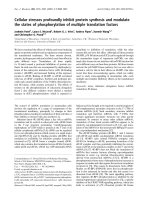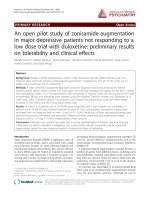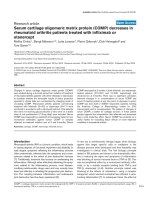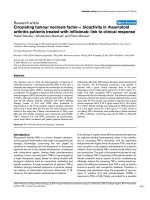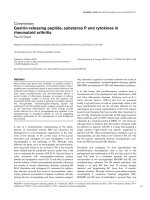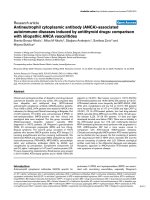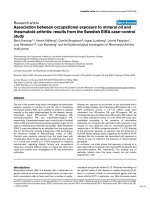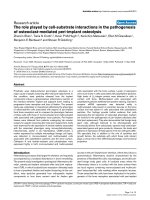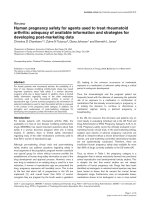Báo cáo y học: "Serum cartilage oligomeric matrix protein (COMP) decreases in rheumatoid arthritis patients treated with infliximab or etanercept" pot
Bạn đang xem bản rút gọn của tài liệu. Xem và tải ngay bản đầy đủ của tài liệu tại đây (177 KB, 5 trang )
Introduction
Rheumatoid arthritis (RA) is a chronic condition, which leads
to varying degrees of functional impairment and disability. In
early stages, symptoms reflecting the inflammatory process
often predominate, whereas later the symptoms and conse-
quences related to the extent of joint destruction increase
[1]. Traditionally, treatment has focused on ameliorating the
inflammation. Although rather effectively alleviating the symp-
toms related to the inflammatory process, most disease-
modifying antirheumatic drugs used until very recently have
been less effective in retarding the progressive joint destruc-
tion. The coupling between inflammation and subsequent
joint destruction has thus been questioned [2].
A new era in antirheumatic therapy began when biologic
agents that target specific cells or mediators in the
disease process were developed and their feasibility was
investigated in clinical trials. The first biologic principle
tested in RA patients and shown to be dramatically effec-
tive in reducing the signs and symptoms of inflammation
was blocking of tumour necrosis factor α (TNF-α) [3]. This
was accomplished either by a monoclonal antibody, inflix-
imab, or by a soluble receptor binding both TNF-α and
TNF-β, etanercept [4–6]. Another principle tested was
blocking of the effects of interleukin-1 using a receptor
antagonist, which seemed somewhat less efficient in ame-
liorating inflammation [7]. In subsequent trials, the effect of
COMP = cartilage oligomeric matrix protein (thrombospondin-5); CRP = C-reactive protein; ELISA = enzyme-linked immunosorbent assay; RA =
rheumatoid arthritis; TNF-α = tumour necrosis factor α.
Available online />Research article
Serum cartilage oligomeric matrix protein (COMP) decreases in
rheumatoid arthritis patients treated with infliximab or
etanercept
Meliha Crnkic
1
, Bengt Månsson
1,2
, Lotta Larsson
1
, Pierre Geborek
1
, Dick Heinegård
2
and
Tore Saxne
1,2
1
Department of Rheumatology, Lund University Hospital, Lund, Sweden
2
Department of Cell and Molecular Biology, Section for Connective Tissue Biology, Lund University, Lund, Sweden
Corresponding author: Tore Saxne ()
Received: 9 Oct 2002 Revisions requested: 20 Nov 2002 Revisions received: 12 Mar 2003 Accepted: 19 Mar 2003 Published: 29 Apr 2003
Arthritis Res Ther 2003, 5:R181-R185 (DOI 10.1186/ar760)
© 2003 Crnkic et al., licensee BioMed Central Ltd (Print ISSN 1478-6354; Online ISSN 1478-6362). This is an Open Access article: verbatim
copying and redistribution of this article are permitted in all media for any purpose, provided this notice is preserved along with the article's original
URL.
Abstract
Changes in serum cartilage oligomeric matrix protein (COMP)
were studied during a 6-month period from initiation of treatment
of rheumatoid arthritis patients with either infliximab or etanercept,
to elucidate whether the favourable results of tissue protection
reported in clinical trials are corroborated by changing levels of
circulating COMP. Rheumatoid arthritis patients commencing
treatment with infliximab (N= 32) or etanercept (N = 17) were
monitored in accordance with a structured protocol. Only patients
who were not receiving glucocorticoids or who were on a stable
dose of oral prednisolone (<10 mg daily) were included. Serum
COMP was measured by a sandwich immunoassay based on two
monoclonal antibodies against human COMP in samples
obtained at treatment initiation and at 3 and 6 months. Serum
COMP decreased at 3 months in both infliximab- and etanercept-
treated patients (P< 0.001 and < 0.005, respectively) and
remained low at 6 months. There was no significant correlation
between changes in or concentrations of serum COMP and
serum C-reactive protein at any time point. A decrease in serum
COMP was seen both in ACR20 responders (patients meeting
the American College of Rheumatology criteria for 20%
improvement) and in nonresponders. The pattern of changes of
serum COMP, a marker for cartilage turnover, in these patient
groups supports the interpretation that infliximab and etanercept
have a joint protective effect. Serum COMP has potential as a
useful marker for evaluating tissue effects of novel treatment
modalities in rheumatoid arthritis.
Keywords: cartilage, COMP, etanercept, infliximab, serum
Open Access
R181
R182
Arthritis Research & Therapy Vol 5 No 4 Crnkic et al.
blocking these cytokines on the progression of joint
destruction has been tested. With radiography of hands
and feet used as an end point, these treatment modalities
show promise in retarding the destructive process [8–10].
Several drawbacks of clinical trials focusing on prevention
of joint destruction can be identified. Since the rate of pro-
gression is slow, the trials must be conducted over a long
period, preferably more than one year, to be able to detect
changes. Furthermore, evaluation relies on radiographic
assessment, which is time-consuming and, despite improve-
ments during recent years, remains a subject of controversy
regarding technical details [11]. Also, radiography is
impractical in early stages of drug development, i.e. for
proof of drug efficacy in small groups of patients or animals.
Alternative or complementary tools to assess progression
of tissue damage should therefore facilitate the evaluation
of treatments with the potential to modify structural joint
damage. Molecular-marker technology is a tool that may aid
in evaluating tissue effects of antirheumatic therapy [12].
One promising candidate is COMP (cartilage oligomeric
matrix protein, also called thrombospondin-5), originally iso-
lated and characterized in cartilage [13]. The first assay
suitable for its measurement in serum and synovial fluid
was described in 1992 and was based on a polyclonal
antiserum and performed as an inhibition ELISA [14].
In this communication, we report the use of a novel sand-
wich ELISA using a combination of two monoclonal anti-
bodies for the detection of COMP in serum. The purpose
of the study was to monitor serum COMP changes during
a 6-month period from initiation of treatment of RA
patients with either infliximab or etanercept. By monitoring
serum COMP, we wanted to elucidate whether the
favourable results of tissue protection reported for the
TNF-blockers could be corroborated by changing levels of
a primarily cartilage-derived marker during treatment.
Materials and methods
Patients
Patients with RA who are treated with infliximab or etaner-
cept at our unit are monitored in accordance with a struc-
tured clinical protocol [15]. All patients have consented to
be included in the protocol. No formal approval by the
ethics committe is required for this protocol, which is an
integrated part of the routine management of these
patients. The protocol includes repeated serum sampling.
The sera are stored at –80°C [14]. The patients included
in the present study were those who at a given time point
were included in the protocol and had been treated for at
least 6 months. They all fulfilled the American College of
Rheumatology criteria for RA [16]. Only patients who were
not receiving glucocorticoids or who were on a stable
dose of prednisolone (<10 mg daily) were included in the
study. Furthermore, no intra-articular glucocorticoid injec-
tions were given during the study period or 3 months prior
to enrolment. The reason for the rigorous control of gluco-
corticoid administration was that previous studies had
indicated that glucocorticoid treatment, whether oral or
intra-articular, may modify serum COMP levels [12]. Inflix-
imab and etanercept were given in accordance with the
standard recommendations, i.e., for infliximab, infusion
intravenously of 3 mg/kg body weight at baseline, week 2,
and week 6 and then every 8 weeks, and, for etanercept,
25 mg subcutaneously twice weekly.
Quantification of serum COMP
Serum COMP was measured by a sandwich ELISA utilis-
ing two monoclonal antibodies directed against separate
antigenic determinants on the human COMP molecule
(AnaMar Medical, Lund, Sweden). The detection limit is
<0.1 u/l and the intra-assay and inter-assay coefficient of
variation is <5%. The assay is not influenced by rheuma-
toid factors. The serum concentrations of COMP obtained
by this assay are highly correlated with serum levels
obtained by the original inhibition assay (r values >0.9 in
RA samples) (T Saxne and D Heinegård, unpublished).
Samples obtained at baseline and after 3 and 6 months of
therapy if available were analysed.
Statistical analyses
Comparisons were done by Wilcoxon’s matched-pairs
test, the Mann–Whitney U-test, or the chi-square test,
where appropriate and correlations were calculated using
Spearman’s rank correlation coefficient. A P value of
<0.05 was considered significant.
Results
Some characteristics of the two groups of patients are
shown in Table 1. There were no significant differences
between the groups in the examined variables.
Serum concentrations of COMP decreased in patients
treated with infliximab or etanercept (Figs 1 and 2). The
decrease was apparent at the 3-month follow-up
(P < 0.001 and <0.005, respectively) and levels remained
low after 6 months compared with baseline values, though
not significant for etanercept. In the etanercept-treated
group, serum COMP decreased in 15 of the 17 patients,
whereas in the infliximab group, serum COMP decreased
in 23 patients and remained unchanged or increased in
9 patients (no significant difference between the groups).
The reason why some of the patients were not included
after 6 months was in most cases that the prednisolone
dosage had been changed and according to the inclusion
criteria these patients were then not eligible for follow-up.
Three patients had stopped taking TNF-blockers after the
3-month follow-up. The serum sample from the 3-month
follow-up was missing for one patient taking etanercept,
and sera from the 6-month follow-up were missing for two
infliximab-treated patients.
R183
The most marked reduction in serum COMP was seen in
the patients with the highest baseline values. The decrease
was significant both in ACR20 responders (patients
meeting the American College of Rheumatology criteria for
20% improvement) at 3 months and in nonresponders for
both drugs (P < 0.05 or better) (Fig. 3). The COMP values
did not correlate significantly with the C-reactive protein
(CRP) values at any time point, nor did the changes
(δ values) in CRP between time points correlate with those
in COMP. The CRP values decreased significantly in the
ACR20 responders in both infliximab- and etanercept-
treated patients (P < 0.001 and P < 0.03, respectively),
whereas in the nonresponders, no significant difference in
CRP values between baseline and the 3-month follow-up
was found. The baseline serum COMP levels did not differ
between patients with or without prednisolone treatment.
Discussion
The COMP levels decreased in both treatment groups
during the initial 3 months of therapy. This suggests that
TNF blockade modifies the release of COMP from the
tissue and supports the interpretation that this treatment
modality retards the development of joint destruction, as
previously indicated [8,10]. Importantly, levels of COMP
decreased both in responders and nonresponders. These
observations taken together are consistent with the
hypothesis that inflammation and tissue destruction are
not directly linked, thus corroborating earlier published
radiographic data on TNF blockade in RA [10]. This inter-
pretation is further supported by the lack of correlation
between CRP levels and between changes in CRP levels
and changes in COMP levels. Although COMP is not
unique to cartilage [17–19], the observations in this study
clearly support a role for serum COMP as a marker reflect-
ing processes not directly linked to the inflammation in RA.
Having this characteristic, COMP adds to the variables
that should be useful to include in the evaluation of poten-
tially tissue-protective antirheumatic drugs. A recently pub-
lished study in which the original inhibition assay was used
for detection of serum COMP supports this conclusion
Available online />Figure 1
Serum COMP (S-COMP) at baseline and after 3 and 6 months in
rheumatoid arthritis patients treated with etanercept. Serum COMP
was lower than at baseline after 3 months (P < 0.005). The levels
remained low after 6 months, although not significantly lower than at
baseline (P = 0.07). See text for details. COMP = cartilage oligomeric
matrix protein (thrombospondin-5).
Figure 2
Serum COMP (S-COMP) at baseline and after 3 and 6 months in
rheumatoid arthritis patients treated with infliximab. Serum COMP was
lower than at baseline after 3 months (P< 0.001). The levels remained
low after 6 months (P< 0.001 compared with baseline). For details, see
text. COMP = cartilage oligomeric matrix protein (thrombospondin-5).
Table 1
Characteristics of patients with rheumatoid arthritis in the two
treatment groups
Treatment
Patients Infliximab Etanercept
No. 32 17
Age (years)
a
56.7 (23.5–80.9) 55.3 (23.2–70.4)
Female/male 25/7 10/7
Duration of disease (years)
a
12.9 (3.0–55.5) 13.7 (2.5–41.0)
Serum CRP at baseline (mg/l)
a
20 (1–84) 36 (1–85)
Serum COMP at baseline 11.3 (5.5–19.2) 12.2 (8.1–29.7)
(u/l)
a
DAS28 at baseline
a
5.3 (2.4–8.1) 5.9 (3.7–7.5)
HAQ at baseline
a
1.4 (0.4–2.8) 1.6 (0.3–2.8)
Monotherapy/combination therapy 5/27 3/14
Prednisolone/no prednisolone 20/12 11/6
ACR20 response at 3 months 16 (50%) 11 (65%)
There were no significant differences between the groups.
a
Median
(range). ACR20 = 20% improvement according to the American
College of Rheumatology criteria; CRP = C-reactive protein; COMP =
cartilage oligomeric matrix protein; DAS = disease activity score;
HAQ = health assessment questionnaire.
[20]. In this study of adalimumab, a fully human anti-TNF-α
monoclonal antibody, in RA, it was shown that baseline
serum COMP was higher in the patient group whose
disease progressed radiographically during a 2-year
period. The COMP levels decreased during treatment in
patients with radiographic progression but remained low
and unchanged in patients with no progression.
We chose to include only patients without glucocorticoid
treatment or with stable, low-dose prednisolone treatment,
which considerably reduced the number of patients eligi-
ble. The reason for this action was, as pointed out above,
that glucocorticoids tend to lower serum COMP levels.
However, this effect does not seem to be due to the anti-
inflammatory effect of glucocorticoids, since the lowering
of serum COMP by glucocorticoids does not correspond
to a decrease in inflammation, e.g. as measured by CRP
or erythrocyte sedimentation rate (ESR) [12]. Instead, it
could be hypothesized that the effect might be due to the
joint protective effect suggested for glucocorticoids
[21,22]. Somewhat in contrast to previous findings, we
did not in this study find any difference in baseline levels
of COMP between low-dose prednisolone users and
patients not taking prednisolone. We have no explanation
for this. However, the possible effect of glucocorticoids on
serum COMP needs to be considered when it is used as
a biomarker, e.g. in drug trials or for clinical purposes.
A drawback of this study is the lack of radiographs for
comparison with the changes in serum COMP levels.
When we started to include patients in the protocol, we
did not include radiographic follow-up, because we did
not anticipate that treatment of patients with advanced RA
with TNF blockers could substantially alter the radio-
graphic appearance of the joints. It turns out that we were
wrong. Furthermore, because of the observational nature
of our protocol, no suitable group for comparison was
available. Since our clinical results accord with the results
of the pivotal trials of infliximab and etanercept that
included radiographs, we believe that our study corrobo-
rates the results of these trials and that the findings
support the use of COMP as a marker of cartilage
processes in RA.
Conclusion
Serum COMP decreases during the first 3 months of
treatment with etanercept or infliximab in patients with RA
in a manner different from changes in symptoms and in
levels of CRP. Thus, COMP shows promise as a non-
inflammation-related marker of the disease process in RA,
which should be useful for evaluating novel treatment
modalities in the disease.
Competing interests
TS and DH are share-holders in AnaMar Medical.
Acknowledgements
Grants were obtained from the Swedish Medical Research Council,
the Gustaf V 80-Year Foundation, the Greta and Johan Kock Founda-
tion, Riksförbundet mot Reumatism, the Crafoord Foundation, the
Nanna Svartz foundation, and the Medical Faculty of Lund University.
The skilful technical assistance of Mrs Mette Lindell is appreciated.
References
1. Welsing PM, van Gestel AM, Swinkels HL, Kiemeney LA, van Riel
PL: The relationship between disease activity, joint destruc-
tion, and functional capacity over the course of rheumatoid
arthritis. Arthritis Rheum 2001, 44:2009-2017.
2. van den Berg WB: Uncoupling of inflammatory and destructive
mechanisms in arthritis. Semin Arthritis Rheum 2001, 30:7-16.
3. Feldmann M, Maini RN: Discovery of TNF-alpha as a therapeu-
tic target in rheumatoid arthritis: preclinical and clinical
studies. Joint Bone Spine 2002, 69:12-18.
4. Elliott MJ, Maini RN, Feldmann M, Long-Fox A, Charles P, Katsikis
P, Brennan FM, Walker J, Bijl H, Ghrayeb J, Woody JN: Treat-
ment of rheumatoid arthritis with chimeric monoclonal anti-
bodies to tumor necrosis factor alpha. Arthritis Rheum 1993,
36:1681-1690.
Arthritis Research & Therapy Vol 5 No 4 Crnkic et al.
R184
Figure 3
Serum COMP (S-COMP) at baseline and after 3 months in rheumatoid
arthritis patients treated with etanercept (a) or infliximab (b), grouped
according to whether they were ACR20 responders (i.e., met the
American College of Rheumatology criteria for 20% improvement) or
nonresponders. Serum COMP was lower than at baseline after
3 months in all groups (P < 0.05 or better). For details, see text and
Table 1.
5. Elliott MJ, Maini RN, Feldmann M, Kalden JR, Antoni C, Smolen
JS, Leeb B, Breedveld FC, Macfarlane JD, Bijl H, Woody JN: Ran-
domised double-blind comparison of chimeric monoclonal
antibody to tumour necrosis factor alpha (cA2) versus
placebo in rheumatoid arthritis. Lancet 1994, 344:1105-1110.
6. Moreland LW, Baumgartner SW, Schiff MH, Tindall EA, Fleis-
chmann RM, Weaver AL, Ettlinger RE, Cohen S, Koopman WJ,
Mohler K, Widmer MB, Blosch CM: Treatment of rheumatoid
arthritis with a recombinant human tumor necrosis factor
receptor (p75)-Fc fusion protein. N Engl J Med 1997, 337:141-
147.
7. Bresnihan B, Alvaro-Gracia JM, Cobby M, Doherty M, Domljan Z,
Emery P, Nuki G, Pavelka K, Rau R, Rozman B, Watt I, Williams B,
Aitchison R, McCabe D, Musikic P: Treatment of rheumatoid
arthritis with recombinant human interleukin-1 receptor
antagonist. Arthritis Rheum 1998, 41:2196-2204.
8. Bathon JM, Martin RW, Fleischmann RM, Tesser JR, Schiff MH,
Keystone EC, Genovese MC, Wasko MC, Moreland LW, Weaver
AL, Markenson J, Finck BK: A comparison of etanercept and
methotrexate in patients with early rheumatoid arthritis. N
Engl J Med 2000, 343:1586-1593.
9. Jiang Y, Genant HK, Watt I, Cobby M, Bresnihan B, Aitchison R,
McCabe D: A multicenter, double-blind, dose-ranging, ran-
domized, placebo-controlled study of recombinant human
interleukin-1 receptor antagonist in patients with rheumatoid
arthritis: radiologic progression and correlation of Genant and
Larsen scores. Arthritis Rheum 2000, 43:1001-1009.
10. Lipsky PE, van der Heijde DM, St Clair EW, Furst DE, Breedveld
FC, Kalden JR, Smolen JS, Weisman M, Emery P, Feldmann M,
Harriman GR, Maini RN: Infliximab and methotrexate in the
treatment of rheumatoid arthritis. Anti-Tumor Necrosis Factor
Trial in Rheumatoid Arthritis with Concomitant Therapy Study
Group. N Engl J Med 2000, 343:1594-1602.
11. van der Heijde D, Simon L, Smolen J, Strand V, Sharp J, Boers M,
Breedveld F, Weisman M, Weinblatt M, Rau R, Lipsky P: How to
report radiographic data in randomized clinical trials in
rheumatoid arthritis: guidelines from a roundtable discussion.
Arthritis Rheum 2002, 47:215-218.
12. Saxne T, Månsson B: Molecular markers for assessment of
cartilage damage in rheumatoid arthritis. In Rheumatoid Arthri-
tis: New Frontiers in Pathogenesis and Treatment. Edited by
Firestein G, Panayi GS, Wollheim FA. Oxford: Oxford University
Press, 2000:291-304.
13. Hedbom E, Antonsson P, Hjerpe A, Aeschlimann D, Paulsson M,
Rosa-Pimentel E, Sommarin Y, Wendel M, Oldberg A, Heinegård
D: Cartilage matrix proteins. An acidic oligomeric protein
(COMP) detected only in cartilage. J Biol Chem 1992, 267:
6132-6136.
14. Saxne T, Heinegård D: Cartilage oligomeric matrix protein: a
novel marker of cartilage turnover detectable in synovial fluid
and blood. Br J Rheumatol 1992, 31:583-591.
15. Geborek P, Crnkic M, Petersson IF, Saxne T: Etanercept, inflix-
imab, and leflunomide in established rheumatoid arthritis:
clinical experience using a structured follow up programme in
southern Sweden. Ann Rheum Dis 2002, 61:793-798.
16. Arnett FC, Edworthy SM, Bloch DA, McShane DJ, Fries JF,
Cooper NS, Healey LA, Kaplan SR, Liang MH, Luthra HS,
Medsger Jr TA, Mitchell DM, Neustadt DH, Pinals RS, Schaller
JG, Sharp JT, Wilder RL, Hunder GG: The American Rheuma-
tism Association 1987 revised criteria for the classification of
rheumatoid arthritis. Arthritis Rheum 1988, 31:315-324.
17. DiCesare P, Hauser N, Lehman D, Pasumarti S, Paulsson M: Car-
tilage oligomeric matrix protein (COMP) is an abundant com-
ponent of tendon. FEBS Lett 1994, 354:237-240.
18. Smith RK, Zunino L, Webbon PM, Heinegård D: The distribution
of cartilage oligomeric matrix protein (COMP) in tendon and
its variation with tendon site, age and load. Matrix Biol 1997,
16:255-271.
19. Recklies AD, Baillargeon L, White C: Regulation of cartilage
oligomeric matrix protein synthesis in human synovial cells
and articular chondrocytes. Arthritis Rheum 1998, 41:997-
1006.
20. den Broeder AA, Joosten LA, Saxne T, Heinegård D, Fenner H,
Miltenburg AM, Frasa WL, van Tits LJ, Buurman WA, van Riel PL,
van de Putte LB, Barrera P: Long term anti-tumour necrosis
factor alpha monotherapy in rheumatoid arthritis: effect on
radiological course and prognostic value of markers of carti-
lage turnover and endothelial activation. Ann Rheum Dis 2002,
61:311-318.
21. Kirwan JR: The effect of glucocorticoids on joint destruction in
rheumatoid arthritis. The Arthritis and Rheumatism Council
Low-Dose Glucocorticoid Study Group. N Engl J Med 1995,
333:142-146.
22. van Everdingen AA, Jacobs JW, Siewertsz Van Reesema DR,
Bijlsma JW: Low-dose prednisone therapy for patients with
early active rheumatoid arthritis: clinical efficacy, disease-
modifying properties, and side effects: a randomized, double-
blind, placebo-controlled clinical trial. Ann Intern Med 2002,
136:1-12.
Correspondence
Tore Saxne, Department of Rheumatology, Lund University Hospital,
S-221 85 Lund, Sweden. Tel: +46 46 171627; fax: +46 46 128468;
e-mail:
Available online />R185
